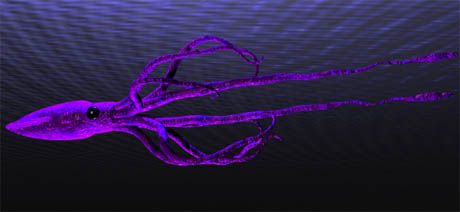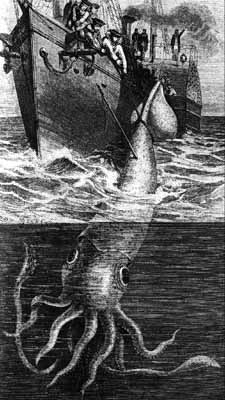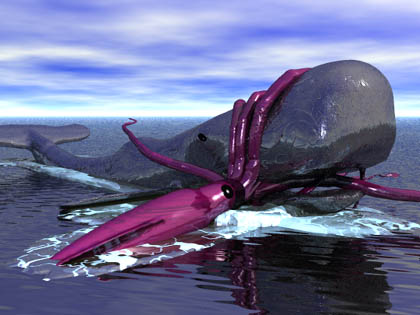pop up description layer
HOME
Cryptozoology UFO Mysteries Aviation Space & Time Dinosaurs Geology Archaeology Exploration 7 Wonders Surprising Science Troubled History Library Laboratory Attic Theater Store Index/Site Map Cyclorama

Custom Search
|
|
The Giant Squid
The French dispatch steamer Alecton was cruising off the Canary Islands late in November of 1861 when its crew spotted something unusual in the water. It looked like a large sea monster with many arms and a long tail. The gunboat, firing cannon and musket at the strange apparition, pursed it until they could get close enough to throw harpoons into it's body. The harpoons wouldn't stay in the flesh for long, but finally the crew managed to get a noose around the tail of the monster. As they tried to pull the thing aboard, the rope tightened and cut though the animal. Most of the creature sank into the sea, but the ship's captain, decided to take the tail of the thing back to the French Consul at Tenerife. From there the tail, and a report about the creature, made its way to the French Academy of Sciences.
At the Academy the report was widely ridiculed. No serious scientist could believe in such a creature. As one member said, It was against the laws of nature. Against the laws of nature or not, the creature seen by the Alecton's crew did exist. Today we know that this creatures is real. What the Alectron sailors saw was the giant squid, or its close cousin, the colossal squid. Giant Squid Habits The existence of the giant squid, genus Architeuthis, is well accepted by science though few have ever been seen, and little is known about their habits. Giant squid are carnivorous mollusks that have a long, torpedo shaped body. At one end, surrounding a beak-like mouth strong enough to cut through steel cable, are five pairs of arms. One pair, thinner and longer than the rest, are used to catch food and bring it to the mouth. Just past the mouth are the eyes. Eyes that are the largest in the animal kingdom, getting as big as eighteen inches across. All squid move through the ocean using a jet of water forced out of the body by a siphon. They eat fish, other squid, and perhaps some argue, in the case of the largest species, whales. The legend of the Kraken, a many armed sea monster that could pull a whole ship under, may have been based on the giant squid. The largest giant squid ever measured was discovered at Timble Tickle on November 2, 1878. Three fisherman were working not far off shore when they noticed a mass floating on the ocean they took to be wreckage. They investigated and found a giant squid had run aground. Using their anchor as a grappling hook they snagged the still living body and made it fast to a tree. When the tide went out the creature was left high and dry. When the animal died, the fishermen measured it and then chopped it up for dog meat. The body of the squid was twenty feet from tail to beak. The longer tentacles measured thirty five feet and were tipped with four inch suckers. Odd Encounters with Whales
We know the giant squid tangles with whales from eye-witness accounts. In October 1966, two lighthouse keepers at Danger Point, South Africa, observed a baby southern right whale under attack from a giant squid. For an hour and a half the monster clung to the whale trying to drown it as the whale's mother watched helplessly. "The little whale could stay down for 10 to 12 minutes, then come up. It would just have enough time to spout - only two or three seconds - and then down again." The squid finally won and the baby whale was never seen again. Giant Squid have been seen in battle with adult whales too. In 1965, a Soviet whaler watched a battle between a squid and a 40 ton sperm whale. In this case neither were victorious. The strangled whale was found floating in the sea with the squid's tentacles wrapped around the whale's throat. The squid's severed head was found in the whale's stomach.
Sperm whales eat squid and originally it had been thought that such battles were the result of a sperm whale taking on a squid that was just too large to be an easy meal. The incident with the Brunswick might suggest otherwise. The Brunswick was a 15,000 ton auxiliary tanker owned by the Royal Norwegian Navy. In the 1930's it was attacked at least three times by giant squid. In each case the attack was deliberate as the squid would pull along side of the ship, pace it, then suddenly turn, run into the ship and wrap it's tentacles around the hull. The encounters were fatal for the squid. Since the animal was unable to get a good grip on the ship's steel surface, the animals slid off and fell into the ship's propellers. Perhaps, for some unknown reason, the Brunswick looked like a whale to the squids. This might suggest that the sperm whale is not always the aggressor in the battles. In fact, though many sperm whales have been captured, few of their stomachs seemed to contain parts of giant squids (though smaller squids seem to provide a large portion of the sperm whale's diet) Unfortunately for scientists, but good for the rest of us, humans do not meet up with giant squids very often. (There is at least one report from World War II of survivors of a sunken ship being attacked by a giant squid that ate one of the party) Squids are thought to be deep dwelling, open sea creatures. Work by Dr. Ole Brix, of the University of Bergen, indicates the blood of squids does not carry oxygen very well at higher temperatures. A squid might actually suffocate in warm water.
According to Dr. Malcom Clarke, of the Marine Biological Association , temperature also seems to affect the squid's buoyancy mechanism. Warm water will cause a giant squid to rise to the surface and not be able to get back down. With water temperature even higher at the surface, the squid maybe doomed. It is not surprising then, that most squid groundings occur near where two ocean streams, one cold and one warm, meet. Perhaps the squid found himself suddenly in water too warm for him. Caught on Film Despite numerous attempts rarely has anyone ever seen a giant squid in the deep sea, so it is very hard for scientists to know much about how they live. In 2004 scientists from National Science Museum of Japan and the Ogasawara Whale Watching Association were more fortunate and took the first live still pictures of a giant squid in its natural habitat. Traveling to a known sperm whale hunting ground about 600 miles south of Tokyo, they dropped a 3,000 foot line baited with squid and shimp and armed with a camera overboard. When a 26 foot long squid attacked the bait the team was able to get hundreds of photographs. Two years later the team from the National Science Museum of Japan was able to get video of an 11 foot long female near the Ogasawara Islands, about 620 miles south of Tokyo. How big can a squid get? Some people have estimated based on peices of carcasses found in the belly's of sperm whales that they might grow as large as one hundred feet, though no squid near this size has ever been scientifically documented. One unconfirmed story, though, suggests they might get even larger. One night during World War II a British Admiralty trawler was lying off the Maldive Islands in the Indian Ocean. One of the crew, A. G. Starkey, was up on deck, alone, fishing, when he saw something in the water:
"As I gazed, fascinated, a circle of green light glowed in my area of illumination. This green unwinking orb I suddenly realized was an eye. The surface of the water undulated with some strange disturbance. Gradually I realized that I was gazing at almost point-black range at a huge squid." Starkey walked the length the of the ship finding the tail at one end and the tentacles at the other. The ship was over one hundred and seventy five feet long.
A Partial Bibliography There are Giants in the Sea by Michael Bright, Robson Books, 1989. The Search for the Giant Squid by Richard Ellis, The Lyons Press 1998. Copyright Lee Krystek 1996-2013. All Rights Reserved. |
|
Related Links |
|
|






 Smithsonian Squid Exhibit.
Smithsonian Squid Exhibit.